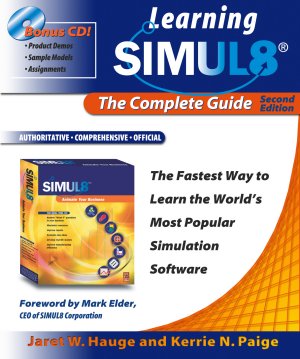SIMUL8 2010 - Notable New Features
SIMUL8's latest edition has just been released. Here are the details on what we think are the most useful new features.
Entries in Exceptional (4)
Dynamic Calendars for Objects
SIMUL8 2010's new object calendars let you turn simulation objects (including resources) on or off according to a date-based availability pattern. Calendars also allow you to tie your simulation directly to a specific date. For example, you can start your simulation on Jan. 1, 2010 and have all work centers shut down on Dec. 25, 2010.
The calendars feature recurring events (daily, weekly, monthly etc.) and are fully supported by Visual Logic, so you can completely configure and control your calendars even at run time.
We think that many users will find this to be a very useful and convenient capability.

 Exceptional,
Exceptional,  Professional
Professional Enhancements to Custom Reports
Custom Reports let you automatically create professional reports to help you effectively communicate the results of your simulation. Improvements inculde a new text format palette, image drag-and-drop, and the ability to insert tables. You can create as many custom reports as you like.
Also included is a new Visual Logic event that runs before a report is opened. This allows you to dynamically adjust the content of your report, giving you total control and flexibility.
Enhanced custom reports are available only in the professional edition.

 Exceptional,
Exceptional,  Professional
Professional Spreadsheet Based Charts
Although SIMUL8 has had charts in their internal spreadsheets for more than 10 versions, they were not dynamic. This meant that your chart would only remain correct as long as the number of data points didn't change.
SIMUL8 2010 solves this problem by allowing you to dynamically create charts from data stored within SIMUL8 internal spreadsheets. The new dynamic charts also allow for totally customized axes, data ranges, series and points. This gives you complete control over your charts at run time.

 Exceptional,
Exceptional,  Professional
Professional Agent Based Simulation
SIMUL8 has responded to the buzz on agent based simulation by adding Visual Logic directly to work items. While not everyone has a need for this capability, there are some applications that will now be much easier to model. Common applications include consumer behavior, social networks, edpidemiology, and evacuation to name just a few.
In standard Discrete Event Simulation languages (of which SIMUL8 has long been an example), all intelligence in a system is encapsulated in the simulation objects (such as work centers). Work items are passive and are simply passed around according to the logic of the other objects. In an agent-based simulation, however, the work items themselves have intelligence and may interact with other work items.
SIMUL8 2010 makes it possible to incoroprate work item-based intelligence into your model by allowing you to attach Visual Logic code directly to work items. Even better, because all of SIMUL8's discrete event and continuous simulation features are still there, you can now create powerful hybrid models.
 Exceptional,
Exceptional,  Professional
Professional 
